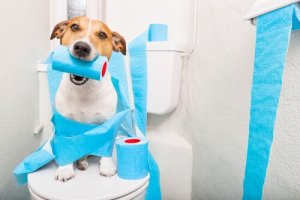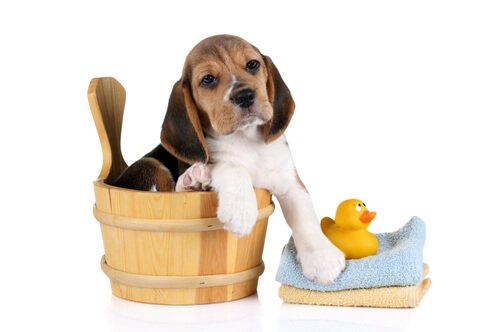Hygiene Habits: Training for Your Dog


Written and verified by the lawyer Francisco María García
Your dog’s training should include certain hygiene habits that will help prevent behavioral problems and the proliferation of disease in your home. Below, we offer you three simple steps to help you train your dog in good hygiene habits.
Three basic steps for good hygiene habits
Ideally, you should start teaching your dog these hygiene habits when they’re still a puppy. But, on the other hand, if you’ve decided to adopt an adult dog, then it’s also possible to educate and socialize them with a little bit of patience and affection.
In both cases, remember to use positive reinforcement, in order to stimulate their learning. You should start teaching them as soon as they arrive in their new home.
Hygiene habit 1: Define where your dog is allowed to go in the home
The moment your dog arrives at their new home, it’ll be essential to determine the places he can and can’t access. We’re not just talking about where he can or can’t relieve his physiological needs, but also about the areas of the home where he’s allowed to roam around freely.
Of course, those who live in the house determine the rules. It’s your choice to define what your rules will be and to teach them to your furry friend. The important thing is to state these rules clearly and objectively so that they can understand how they should behave in their new home.
One point to consider is whether your dog is allowed on the couch or in your bed. If the answer is no, then clearly show him that these places are not allowed, and what regions of the home he can access.

Hygiene habit 2: Determine their meal schedules
This is one of the most important things about instilling hygiene habits in a dog. Your pet needs to understand that there are meal times for them and for us. They should know that they have to respect our mealtimes. It’s also essential to teach them not to look for food in the trash.
Even if a dog begs for food at your table, it’s not advisable to reinforce this behavior. It’s necessary to prevent these bad habits right from the start.
Neither should we give food or treats to our dog to make him stop unwanted behavior, such as barking excessively. Unfortunately, this almost always leads to the animal thinking that they’re being rewarded for what we consider to be bad behavior.
Ideally, you should divide the total amount of food that your dog consumes per day into two or three meals. In this way, you’ll ensure that they don’t go too many hours without eating, and that they’ll be able to resist the temptation to rummage around the trash or the kitchen to find some.
Hygiene habits 3: Teach your dog to relieve himself in the right place
One of the most important hygiene habits is to teach your dog to relieve himself in the right place. To do this, you must first define if you want the dog to do so outside, or in a specific area in your home.
We advise you to teach your dog to do his business outside. Not only does this give you better hygiene in the home but, in addition, it’s also an excellent mental exercise for your pet.

Starting to walk your dog
Before you take your dog out, you’ll need to complete their first cycle of vaccines. Usually, this happens when a dog is about three to four months old.
During this period, you can get your dog used to walking with a harness or a collar in the house. You can do some small walks inside, and teach him not to pull on the leash and to walk in a calm, obedient way.
When the time comes, then you can decide a schedule for your dog’s walks. Remember that it’s essential to establish a routine for your dog, in order for him to assimilate and understand that these are the times when he should do his business.
During the walks, you should always let your dog sniff freely, express himself, and interact with other dogs. Additionally, each time they urinate or defecate outside offer them a reward in order to reinforce that behavior.
Excessive retention of urine can lead to problems in the urinary tract. It’s also very uncomfortable for a dog, and, for this reason, it’s best to prevent accidents. You can leave an absorbent towel or a newspaper where the dog can relieve himself when they’re alone.
Bowel movements work in mysterious ways, and every animal has their own personal schedule!
Your dog’s training should include certain hygiene habits that will help prevent behavioral problems and the proliferation of disease in your home. Below, we offer you three simple steps to help you train your dog in good hygiene habits.
Three basic steps for good hygiene habits
Ideally, you should start teaching your dog these hygiene habits when they’re still a puppy. But, on the other hand, if you’ve decided to adopt an adult dog, then it’s also possible to educate and socialize them with a little bit of patience and affection.
In both cases, remember to use positive reinforcement, in order to stimulate their learning. You should start teaching them as soon as they arrive in their new home.
Hygiene habit 1: Define where your dog is allowed to go in the home
The moment your dog arrives at their new home, it’ll be essential to determine the places he can and can’t access. We’re not just talking about where he can or can’t relieve his physiological needs, but also about the areas of the home where he’s allowed to roam around freely.
Of course, those who live in the house determine the rules. It’s your choice to define what your rules will be and to teach them to your furry friend. The important thing is to state these rules clearly and objectively so that they can understand how they should behave in their new home.
One point to consider is whether your dog is allowed on the couch or in your bed. If the answer is no, then clearly show him that these places are not allowed, and what regions of the home he can access.

Hygiene habit 2: Determine their meal schedules
This is one of the most important things about instilling hygiene habits in a dog. Your pet needs to understand that there are meal times for them and for us. They should know that they have to respect our mealtimes. It’s also essential to teach them not to look for food in the trash.
Even if a dog begs for food at your table, it’s not advisable to reinforce this behavior. It’s necessary to prevent these bad habits right from the start.
Neither should we give food or treats to our dog to make him stop unwanted behavior, such as barking excessively. Unfortunately, this almost always leads to the animal thinking that they’re being rewarded for what we consider to be bad behavior.
Ideally, you should divide the total amount of food that your dog consumes per day into two or three meals. In this way, you’ll ensure that they don’t go too many hours without eating, and that they’ll be able to resist the temptation to rummage around the trash or the kitchen to find some.
Hygiene habits 3: Teach your dog to relieve himself in the right place
One of the most important hygiene habits is to teach your dog to relieve himself in the right place. To do this, you must first define if you want the dog to do so outside, or in a specific area in your home.
We advise you to teach your dog to do his business outside. Not only does this give you better hygiene in the home but, in addition, it’s also an excellent mental exercise for your pet.

Starting to walk your dog
Before you take your dog out, you’ll need to complete their first cycle of vaccines. Usually, this happens when a dog is about three to four months old.
During this period, you can get your dog used to walking with a harness or a collar in the house. You can do some small walks inside, and teach him not to pull on the leash and to walk in a calm, obedient way.
When the time comes, then you can decide a schedule for your dog’s walks. Remember that it’s essential to establish a routine for your dog, in order for him to assimilate and understand that these are the times when he should do his business.
During the walks, you should always let your dog sniff freely, express himself, and interact with other dogs. Additionally, each time they urinate or defecate outside offer them a reward in order to reinforce that behavior.
Excessive retention of urine can lead to problems in the urinary tract. It’s also very uncomfortable for a dog, and, for this reason, it’s best to prevent accidents. You can leave an absorbent towel or a newspaper where the dog can relieve himself when they’re alone.
Bowel movements work in mysterious ways, and every animal has their own personal schedule!
This text is provided for informational purposes only and does not replace consultation with a professional. If in doubt, consult your specialist.








